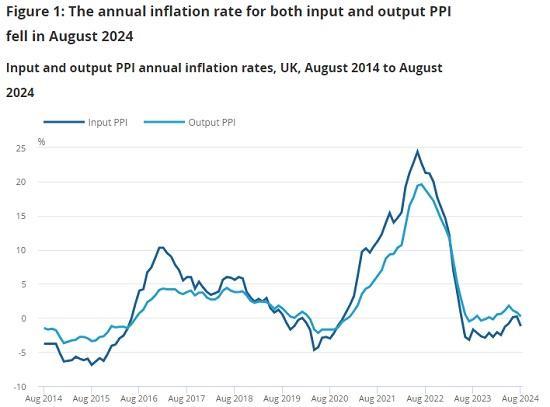Producer Price Inflation UK - August 2024
18th September 2024

Producer input prices fell by 1.2% in the year to August 2024, down from a revised increase of 0.2% in the year to July 2024.
Producer output (factory gate) prices rose by 0.2% in the year to August 2024, down from an increase of 0.8% in the year to July 2024.
On a monthly basis, producer input prices fell by 0.5%, while output (factory gate) prices fell by 0.3% in August 2024.
Producer price inflation rates
Producer input prices fell by 1.2% in the year to August 2024. This is down from a revised increase of 0.2% in the year to July (Figure 1). Monthly input prices fell by 0.5% in August 2024, following a revised fall of 0.3% in July (Table 1).
Producer output (factory gate) prices rose by 0.2% in the year to August 2024. This is down from an increase of 0.8% in the year to July (Figure 1). Monthly output prices fell by 0.3% in August 2024, following a flat rate of 0.0% in July (Table 1).
Estimates for both July and August 2024 are provisional. Figures for the latest 12 months are subject to revisions as additional survey data are returned and validated. Effective response rates at the time of first publishing can be found in Section 7: Data sources and quality.
Because of rounding, inflation rates in this bulletin may not correspond to index value changes, and contributions to the rate may not add up to the rate exactly.
We have now published feedback from the user engagement exercise we launched earlier this year. The purpose of the exercise was to better understand user needs as part of a review of outputs and publications for Producer Price Index (PPI) statistics.
Input producer price inflation
Of the 10 product groups for the input Producer Price Index (PPI), 4 made downward contributions to the annual inflation rate in August 2024. The largest of these came from inputs of crude oil and fuels, which contributed negative 0.84 and negative 0.66 percentage points, respectively (Figure 2).
The prices of inputs of crude oil fell by 14% in the year to August 2024, which is down from a rise of 8.4% in the year to July (Table 2). Inputs of crude oil also provided the largest contribution to the change in the annual inflation rate between July and August 2024, with a downward contribution of 1.34 percentage points.
The prices of inputs of fuels fell by 13.5% in the year to August 2024, which is down from a fall of 12.5% in the year to July. The main contribution to this fall came from electricity for domestic market which fell by 13.2% in the year to August 2024.
The largest offsetting upward contributions came from inputs of domestic food, and metals and non-metallic mineral products, which contributed 0.32 and 0.30 percentage points, respectively (Figure 2).
Prices for inputs of domestic food increased by 0.7% in the year to August 2024 (Table 2). This upward contribution was partly caused by a poor yield in potato crops which pushed prices up.
Prices for inputs of metals and non-metallic mineral products rose by 0.8% in the year to August 2024. The main contribution came from aluminium for domestic market.
Output producer price inflation
Of the 10 product groups for the output Producer Price Index (PPI), 7 made upward contributions to the annual inflation rate in August 2024. The largest of these came from "other outputs" and coke and refined petroleum products which contributed 0.92 and 0.73 percentage points, respectively (Figure 3).
Prices for "other outputs" rose by 1.5% in the year to August 2024, up from a rise of 1.2% in the year to July (Table 4). The main contribution to this rise came from soft drinks; mineral waters and other bottled waters for domestic market, which rose 1.0% in the year to August 2024.
Despite providing the second largest upward contribution on the year, coke and refined petroleum products had a growth rate of negative 9.5%. This upward contribution was caused by the weight changes introduced to the PPI in February. For worked examples, see the scenarios in Section 7: Data sources and quality. Coke and refined petroleum products also made the largest contribution to the change in the annual inflation rate in August 2024, with a downward contribution of 0.90 percentage points.
In comparison, the largest offsetting downward contributions came from outputs of chemicals and pharmaceutical preparations, and paper products, which detracted 1.23 and 1.05 percentage points, respectively.
Chemical prices fell by 1.3% in the year to August 2024 (Table 4). This decrease was mainly caused by paints, varnishes and similar coatings, printing ink and mastics for domestic market, which fell by 0.7% in the year to August 2024.
Read the full ONS report HERE
